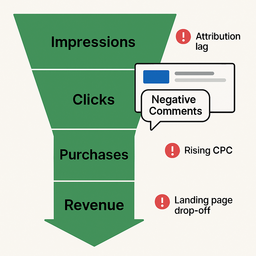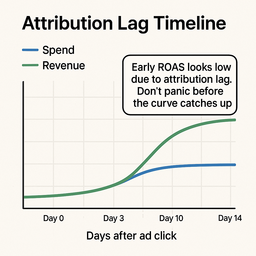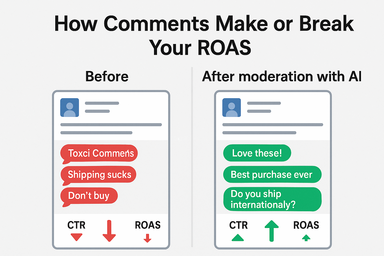December 4, 2025
A data-backed breakdown of the real comment patterns driving ad performance in 2025.
Aug 21, 2025
8 Mins
Discover 13 reasons why your ROAS is dropping and how to fix them — from CPC and AOV to the hidden impact of ad comments. A practical guide for ecommerce founders.

If you’re an ecommerce founder, few things sting more than watching your ROAS suddenly tank. You’re spending the same money, running the same ads, and yet the returns are drying up.
This happens more often than you’d think. And while most advice online points to the “usual suspects” like higher CPC or creative fatigue, there’s one silent killer almost nobody talks about: the comments on your ads.
Those troll posts, spam drops, and customer complaints sitting right below your creatives are acting like a negative review wall. Every prospective buyer sees them before clicking. If left unmanaged, they drag down trust, lower CTR, and push CPC higher — a direct hit to your ROAS.
In this article, we’ll break down 13 reasons your ROAS might be dropping (including the overlooked role of ad comments), how to diagnose the real issue, and what to do about it. By the end, you’ll have a playbook to stop the bleeding and reclaim profitable campaigns.

The first step is to figure out if the drop you’re seeing is even real.
Attribution delays (“ROAS lag”): Platforms like Meta and Amazon record spend immediately, but conversions take time to report. If you’re looking at yesterday’s data, your ROAS may look awful — when in reality, revenue just hasn’t been attributed yet. Always wait 7–14 days before making big decisions.
Tracking or reporting glitches: Misfiring pixels, duplicate events, or GA4 misconfigurations can all skew results. A sudden 50% ROAS drop is often a data issue, not a performance issue.
Before you start slashing budgets, confirm your data.
Measurement breakdowns create phantom ROAS drops.
SKAdNetwork / API problems: Apple’s privacy changes mean missing postbacks are common. If you’re not stitching data together properly, your ROAS will look artificially low.
Double-counted spend or missed revenue events: Always cross-check Ads Manager against billing and your CRM. If numbers don’t line up, it’s not performance — it’s reporting.

Practical fix: Build redundancy into your tracking. Use both server-side events and pixel events so you’re not at the mercy of one pipeline.
Too little budget can choke performance.
Underfunded campaigns stall delivery: Platforms need a certain threshold of spend to optimize. A $20/day budget in a competitive category may never get enough conversions to exit the learning phase.
Budget caps at the wrong time: If you throttle budgets right as the algorithm is learning, you stop momentum cold. That shows up as worsening ROAS.
Practical fix: Scale budgets gradually — no more than 20% changes per day — so you don’t reset learning.
CPC directly eats into ROAS. If CPC doubles, your conversion rate has to double just to break even.
Increased competition: More brands are bidding for the same audience, driving CPC up.
Ad relevance score dropping: This is where comments matter. If your ad is full of spam or angry posts, relevance scores drop. The platform reads that as low engagement, which raises CPC.
Practical fix: Keep your ads clean. Hiding toxic comments improves relevance and lowers CPC, often more cheaply than changing bids.
Even if ads are stable, math can sink you.
Lower AOV = weaker ROAS: If customers are buying less per order, your revenue side shrinks.
Fixes: Add bundles, upsells, or incentives that lift cart size. For example, “Buy 2, get 15% off” instantly boosts AOV and restores ROAS balance.
Great creatives don’t last forever.
Repetition leads to ad blindness: If frequency creeps past ~1.8, people tune out. CTR falls, CPC rises, and ROAS crashes.
Rotating fresh creatives: Swap formats (video, carousel, UGC) and refresh messaging often.
Layer in moderation: Even the best new creative can flop if the comments underneath are toxic. A fresh ad buried under shipping complaints still looks bad.
Sometimes your worst competitor is yourself.
Internal competition: If multiple ad sets target similar lookalikes, you’re driving up your own CPC.
Overlap tools: Use Facebook’s Audience Overlap tool to spot wasted budget.
Practical fix: Consolidate overlapping ad sets and let one strong campaign win.
Even perfect creatives flop if they’re shown to the wrong people.
Poor audience fit: Broad targeting may give reach, but it often drains ROAS.
Audience drift: Over time, lookalikes can expand into less relevant profiles, driving down efficiency.
Fixes: Refresh seed audiences, run tighter exclusions, and split prospecting vs retargeting clearly.
Ads get the click. The page does the selling.
Slow load times: Each extra second can drop conversions by 7%.
Mismatched messaging: If your ad promises “Free Shipping Today” but your page hides that detail, trust evaporates.
Fix: Run A/B tests on your landing pages alongside your ads. Don’t just optimize one piece of the funnel.
Sometimes the market changes around you.
Competitors underpricing: If your competitors slash prices, your conversion rates will drop even if your ads are stable.
Fixes: Don’t race to the bottom. Add value with free shipping, better service, or bundles instead of discounts that destroy margins.
Demand naturally shifts.
Post-peak dips: After big sales periods (holidays, back-to-school), conversion rates fall. ROAS drops are expected.
Fixes: Plan for seasonality. Use evergreen campaigns to smooth valleys, and don’t depend on one product category.
Algorithms don’t ask permission.
Meta/TikTok updates: Privacy changes, delivery tweaks, or new ad formats can sink performance overnight.
Fixes: Stay plugged into ad buyer communities. You’ll hear about shifts faster than official announcements.

Most ecommerce founders obsess over creatives, targeting, or landing pages — but scroll down your ad and you’ll often find the real performance killer hiding in plain sight: the comment section.
When someone sees your ad, they don’t just read your copy or watch your video. They scan the comments. If the first thing they see is a complaint about shipping delays or someone shouting “scam,” you’ve just lost trust before you ever earned the click.
Bad comments create three problems at once:
For ecommerce, shipping complaints are the most common. Subtle criticism (“Looks good, but probably breaks in a month”) can be just as damaging.
The impact is measurable. In accounts we’ve worked with, ROAS improves 10–20% simply by hiding harmful comments. Deleting them often backfires — platforms read it as a negative signal. Hiding keeps the algorithm happy while keeping your ad clean.
The fix isn’t crude keyword filters. Someone saying “f*** yes” might actually be your biggest fan. The solution is contextual sentiment analysis — moderating based on meaning, not just words.
Advanced moderation tools make this possible:
Consider one DTC brand we support — a resistance band company where the founder used to debate price objections in the comments for hours a day. With automated moderation, the negative threads collapsed to a single visible objection, while positive buyers reinforced the ad. ROAS rose significantly, and the founder got hours of time back.
You can refresh creatives and tweak bids forever, but if your ad comments are a wall of negativity, you’re paying to drive customers into doubt. Moderation isn’t optional anymore — it’s performance marketing.
When ROAS drops, don’t shotgun solutions. Use a funnel approach:
Hypothesize, test, fix. Always move in loops, not guesses.
Q1. Why does my ROAS drop right after launching a new campaign?
Because of attribution lag. Spend shows up instantly, but conversions trickle in days later.
Q2. How often should I refresh creatives?
Every 2–3 weeks, or sooner if frequency rises above 1.8.
Q3. Can bad comments really lower ROAS?
Yes. They act like one-star reviews under your ad, lowering trust and CTR.
Q4. What’s the cheapest fix for low ROAS?
Often, simply hiding negative comments. It boosts relevance, lowers CPC, and costs nothing extra.
Q5. Should I pause ads during seasonal dips?
Not always. Pivot messaging or diversify SKUs to smooth valleys.
A dropping ROAS is never fun, but it’s not the end of the story. By systematically checking attribution, budgets, CPC, AOV, creative fatigue, and audience alignment, you’ll uncover the real culprit.
And don’t forget the most overlooked lever: your ad comments. They’re the public conversation happening under your ad, shaping trust and performance in real time. Left unmanaged, they quietly destroy ROAS. Managed with the right AI tools, they become an asset — keeping engagement high, lowering CPC, and protecting your margins.
If you’re tired of pouring money into ads only to see comments drag you down, that’s exactly what we solve at Superpower. We help ecommerce brands hide the noise, highlight the advocates, and keep campaigns performing the way they should.
The next time you see a sudden ROAS dip, don’t just blame the algorithm or refresh creatives. Scroll down. Check the comments. Fix them. Because often, that’s where the bleeding starts — and where recovery begins.

Explore expert tips, industry trends, and actionable strategies to help you grow, and succeed. Stay informed with our latest updates.